Lasers are optical amplifiers, optical oscillators, and in a way, the most sophisticated light source ever invented. Not only are lasers extremely useful, but they are also champions of magnitude: While different laser types cover the electromagnetic spectrum from radiation (<10 nm) over the visible spectrum to far infrared light (699 μm), their individual output band can be as narrow as a few µHz. Their high temporal and spatial coherence lets them cover hundreds of meters in a tight beam of lowest divergence as a perfectly sinusoidal, electromagnetic wave. Some lasers reach peak power outputs of several exawatts, while their beams can be focused down to the smallest spot sizes in the hundreds and even tens of nanometers. Laser is the acronym for Light Amplification by Stimulated Emission Of Radiation, which suggests that it makes use of a phenomenon called stimulated emission, but well, how exactly do they do that? It’s time to look the laser in the eye (Disclaimer: don’t!).
The Optical Amplifier
When we talk about the amplification of electrical signals, we are typically not too concerned about whether or not the amplified signal is actually the original signal – just amplified. The minuscule flow of electrons in a bus line may transport a signal, but this signal is not bound to that exact representation. We can send it through a transformer, optocoupler or piezo-transducer and, if we do it right, it just won’t matter. We are really ok if an amplified signal is a good, enlarged copy, as long as the copy retains the subset of properties of the original signal we are interested in.
Light is however indeed bound to its inherent representation as an electromagnetic wave. To understand how light is amplified – or copied – we need to look at the different properties of light both as a wave and as a particle. As a wave, it’s really not much more than synchronized oscillations of electric and magnetic fields propagating through space. To amplify it, we would want to somehow increase the amplitude of this oscillation while leaving its temporal course, such as its phase and frequency, intact. As a particle, however, a photon of a certain wavelength, direction, and polarization – all we can do is add more. So, if take this photon and we add another photon with this very same properties – a copy so to speak – we will see that the amplitude of our electromagnetic wave also doubles. It is amplified.
Since all we can do to amplify light, an optical amplifier must contain some kind of photon xerox — only this one really needs to leave the numbers intact. In lasers, this task of copying photons is done by special atoms (or molecules) inside the optical amplifier. They are called the active laser medium, and in a Helium-Neon laser, for example, it’s the Neon gas. All it needs is a container, an energy source, and some kind of windows for light to enter and exit. This contraption is the key element of every laser, from laser diodes over CO2 laser tubes to fiber lasers.
How To Make A Photon
Most photons we see in everyday life originate from a process called spontaneous emission. Atoms and molecules can be stimulated to transition to higher energy states than their ground state, in which the outer electrons leave their regular orbits and transition into more energetic states. If this state of excitation is long-lived (metastable), they may stay in this state for quite a while, but always keep a certain tendency to translate back to a lower energy state. Sooner or later, they will do so – spontaneously – while emitting a photon of a certain frequency in a random direction and with a random phase. This is called spontaneous emission, and the frequency of the emitted photon depends on the energy differential between the high (E2) and low energy state (E1). Compact fluorescent lamps, as well as incandescent lamps with a halogen filling, make use of this phenomenon.
How To Copy A Photon
Now, if a photon of this exact frequency f21, collides with such an excited atom, it can stimulate the atom to transition back to the low energy state right away, before it has time to do so spontaneously. The electromagnetic field of this original photon causes the atom to turn into an electrical dipole and oscillate with the external field. This deep interaction causes the emitted, new photon to take on the same phase and direction as the original one, which makes it practically a copy. Regarding most of the special properties of lasers, such as high monochromaticity, coherence and diffraction limited divergence angle, this quantum mechanical interaction is pretty much the bottom of the barrel.
However, inversely to stimulated emission, incoming photons can also run into atoms of the laser medium that are in the low-energy ground state. These photons will be absorbed, exciting the atom to the corresponding high-energy state. Unless another photon collides with the same atom soon enough to cause a stimulated emission, this atom is likely to spontaneously fall back to its ground state. It will still release a photon, but the photon released in a spontaneous emission can have any direction or phase and won’t align with the absorbed photon’s direction or phase, which results in an attenuation of incoming light.
Population Inversion
With a large number of atoms of the gain medium, the actual amplification process becomes a statistical sum of collisions. If there is a higher concentration of atoms in a low energy state than in the high energy state, we will experience a net loss of photons and thus, an attenuation of light. If the number of excited atoms is larger than the number of low energy atoms, we will experience a net gain. This overbalance of excited atoms is called the population inversion, and it is a basic requirement for optical amplification.
However, with an overbalance of excited atoms, such a two level system becomes highly unstable – it’s practically impossible to maintain. To achieve a population inversion in a stable system, optical amplifiers and lasers make use of more than two excitation levels of the involved atoms. For example, by exciting atoms from the ground state E1 to an excitation state E3, a population inversion between E3 and an intermediate energy state E2 can occur even if more low energy atoms are present in the ground state E1. As long as atoms transition from E2 to E1 – for example by a secondary spontaneous emission – at the same rate as atoms are lifted up from E1 to E3, the light amplification process at f32 can happen.
Pump it
To achieve the primary excitation of the laser medium to just the right high energy state, we need a mechanism to lift its atoms up there. This action is called pumping. Different types of lasers use different pumping methods, but besides keeping it going in an efficient and feasible way, it has little effect on the stimulated emission process itself. In some cases, the pumping itself is done by secondary light sources, such as discharge tubes or light emitting diodes. In other cases, the pumping is a well-designed bucket-chain of electrons and atoms or molecules passing on energy from a high voltage source to the atoms of the laser medium.
The first laser ever built, the ruby laser, uses photons emitted from a Xenon flash tube to excite chromium ions suspended in a synthetic sapphire. Other crystal lasers, such as Nd:YAG lasers, can be pumped by either arc lamps (or flashes), typically Xenon or Krypton, or more efficiently by light emitting diodes. Generally, diode pumped solid state lasers (DPSSL) use photons emitted from semiconductor diode junctions to pump various laser media.
CO2 lasers use electron collisions to induce a molecular oscillation in N2 molecules, which then pass on their energy and excite the CO2 laser medium. Helium-Neon lasers utilize electron collision to excite Helium atoms, which then collide with and excite the laser medium Neon. Except for CO2 lasers, which are still commonly used in laser cutters, the intricate pumping mechanisms that involve special gas mixtures and high voltages are more and more replaced by diode-based solid state alternatives.
The Optical Oscillator
While the optical amplifier may already be called a laser in a way, most optical amplifiers will not lase on their own. Any amount of photons that is going to be amplified while passing through the amplifier is bound to leave the amplifier very quickly — with light speed — and gone they are. On their way, they will not necessarily experience enough collisions with the atoms of the laser medium to achieve any reasonable lasing action. To make things worse, the optical amplifier amplifies light in all directions, which makes it a CFL tube at best. There are a few tricks to overcome this: One is, to give the optical amplifier a very, very long and narrow shape so that the only photons passing along this long axis of the amplifier will be amplified. Another way can be to increase the density of the gain medium. And eventually, mirrors can be installed on both ends of the optical amplifier to conveniently increase the effective length of the amplifier.
Because high-density gain mediums come with other challenges, such as high breakdown voltages for gaseous mediums, mirrors (and oftentimes long tubes) are the way to go here. Using mirrors, you can also create what is called an optical oscillator. Similar to a mass on a spring, an elastic string, or an LC-oscillator, they oscillate in resonance with a certain frequency. An optical oscillator is even easier to set up, since the main material you need is a chunk of space, with two mirrors on each end to prevent the light from exiting and getting absorbed. In this optical cavity, photons, light or electromagnetic waves (depending on how you look at it) can bounce back and forth between the two mirrors, superimposing to a standing wave.
You may have seen this before, it looks like a standing wave on a string. An optical oscillator behaves very similarly: The modes of this optical cavity are solely dependent on the propagation speed of the wave, in this case lightspeed, and the length of the cavity L. The modes — or resonance frequencies — that fit into our cavity depend mostly on the length of the cavity. If we choose the cavity to be long in comparison to the wavelengths we are interested in, in the hundreds of nanometers for visible light, the frequency response of this cavity shows many tightly and evenly spaced modes. If we choose the length of the cavity to be shorter, the spacing fs between the modes increases. This spacing is an important factor for the power output of industrial multimode lasers, which therefore typically have much longer cavities than for instance diode lasers in optical drives that rely on single frequency operation.
However, all oscillators are subject to losses, and we need to overcome them to keep any oscillation going. In lasers, this is done by — you may have guessed it — the optical amplifier. The optical amplifier goes right in between the mirrors, and if it’s strong enough to overcome the losses of your system, mostly the small amount of absorption in the mirrors, this system will oscillate.
This oscillation is called lasing, and it is really nothing more than electromagnetic waves bouncing back and forth between the mirrors, experiencing resonance from the cavity and recovering their losses when they pass through the amplifier. To make use of them, usually only one of the mirrors is highly reflective, typically 99.9 % or more. The other mirror, the output coupler, is partly transmissive and allows for a small amount, about 1%, of radiation to exit the cavity. Of course, the amplifier also has to compensate for this amount.
How The Laser Starts Lasing
Once we’ve put everything together, our optical cavity with the output coupler and the optical amplifier, we will want to turn it on. The pump medium will start elevating the laser medium to its high energy level, but there is no light inside the cavity to be amplified yet. Still, even with no incoming radiation, some of the excited atoms in the laser medium will randomly translate to a lower energy state, emitting a photon of just the right wavelength, but with random phase and into a random direction. We need only a few of them with the right phase to be directed along the axis of the optical cavity to get the avalanche going. These initial photons will bounce back and forth between the mirrors of the cavity, getting amplified each time, and the laser starts lasing.
Multimode Lasers
Optical cavities support all modes that fit in between the reflectors, so the exact number of wavelengths of light a laser produces depends mostly on the bandwidth of the optical amplifier. If its bandwidth is narrow, it may cover only a single mode of the optical cavity. If its bandwidth is large, multiple modes of the cavity can be amplified, and because this usually allows for a higher utilization of the pump mechanism, it naturally comes with a higher efficiency. Most industrial high power lasers actually don’t emit only a single frequency, but many. This is possible even though the gain medium operates at a very specific frequency defined by its excitation states, and comes by certain side effects depending on other characteristics of the gain medium. In gas mediums, the collisions of photons with atoms or molecules can shorten the decay time, which — following the statistics of these collisions — shapes the bandwidth of the amplifier to a bell curve. Also, Doppler effects due to the fast movement of gas atoms can further broaden the gain curve. There are many secondary imperfections in the various processes of pumping and stimulated emission that are used productively in multimode lasers.
Pulsed lasers
By pulsing a laser, a larger peak power output can be achieved than what continuous operation would make possible. This can, for example, be done electronically, or through a spark gap circuit, and with shorter pulses, higher peak power output values can be obtained. However, limitations in power output and pulse widths limit the usefulness of this approach.
Multimode lasers offer the possibility of achieving extremely short pulses at a very high momentary power output simply by combining the phase-locked modes of the optical cavity. By combining a series of equally spaced modes in the frequency domain, the interference of the modes causes the output to become a series of pulses in the time domain.
The phenomenon of beat, an acoustic interference of sound, where two tones of slightly off frequency create a perceived pulsation of the volume, is very similar. The more modes are superimposed, the shorter and more intense the pulse becomes, and in multimode lasers, they can be as short as a few femtoseconds (10-15 s) while producing several exawatts (1018 W) of peak power.
To achieve this, the modes of the optical cavity need to be tight enough spaced to fit as many as possible into the bandwidth of the optical amplifier. Also, the optical amplifier should have a large enough bandwidth to amplify more than a single frequency.
A Primer On Laser Optics
We still left out a few interesting features hidden in the internal optics of lasers, which are mostly the reflectors. First, the reflectors don’t need to be external, they can be evaporation deposited directly onto the polished windows of the optical cavity. Still, to make the output frequency of the laser tunable – which can be easily achieved by slightly changing the length of the cavity – it is practical to adjustably mount at least one of the mirrors externally. If one or both mirrors are mounted externally, some lasers will be equipped with Brewster windows, which is really just a window with its surface cut to a special angle.
This angle – the Brewster angle – is an angle where only light of a certain, linear polarization experiences can losslessly pass without reflections while all other polarizations are reflected away from the cavity and filtered from the beam. This minimizes reflections and polarizes the laser beam.
Also, the reflectors must not be plain. In some applications, it is advantageous to use concave or a mix of concave and plain or even convex reflectors. Now the beam exiting the output coupler is not parallel anymore, but can be converted into a parallel beam of any diameter by using simple optics.
I hope you enjoyed this very close look at the inner workings of lasers and optical amplifiers. There’s still a lot of engineering to get from here to just throwing a piece of plywood into a laser cutter, writing data in an optical drive, or exposing a photomask for silicon wafer production. Nevertheless, we have even seen impressive DIY builds of ruby lasers, CO2 lasers, and TEA lasers. DIY or industrial grade, they all share the same core principle, a quantum mechanical avalanche of cloned photons.

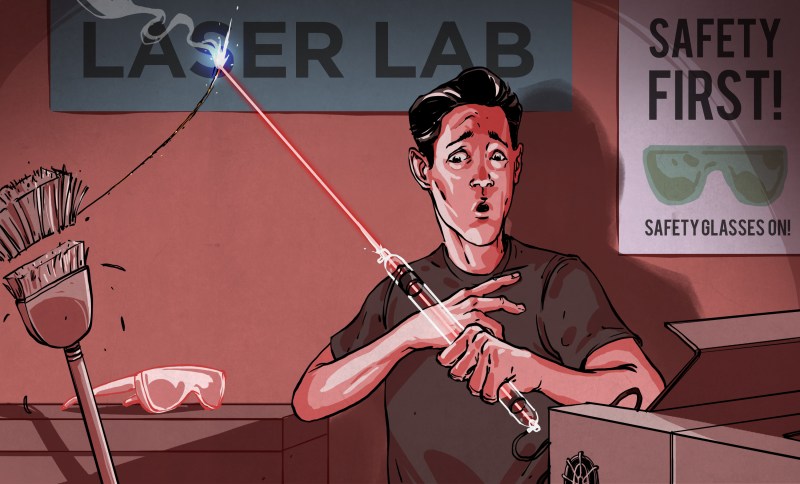
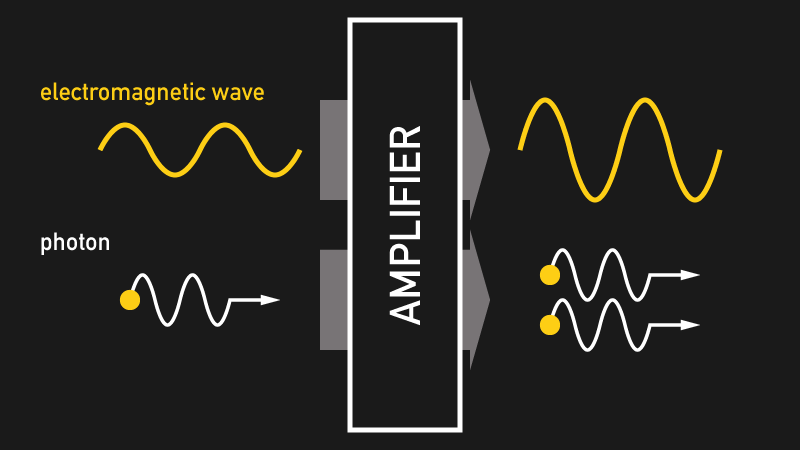

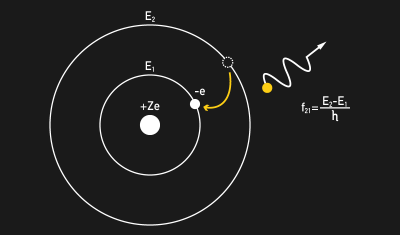
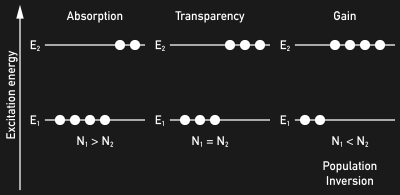
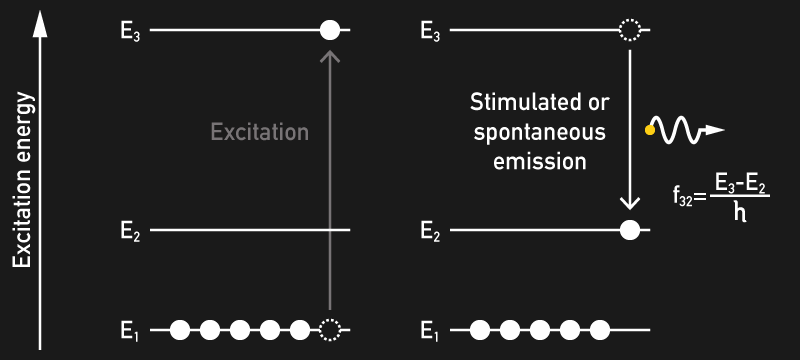

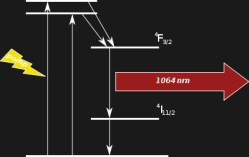
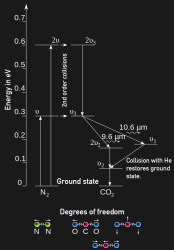

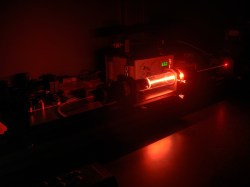
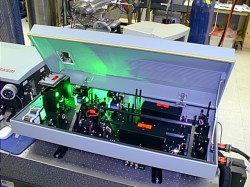
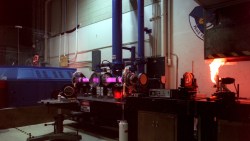
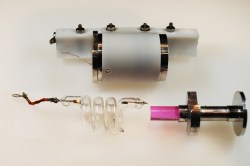


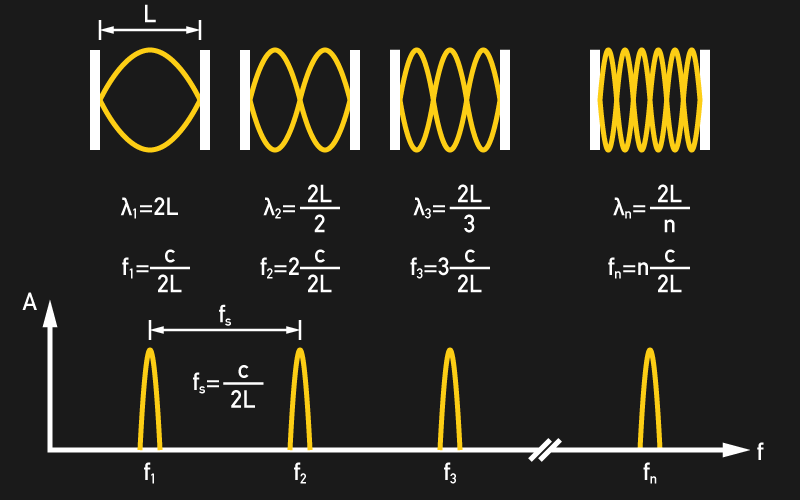
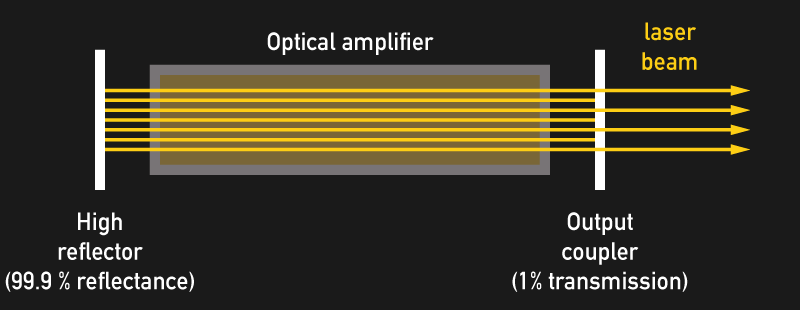
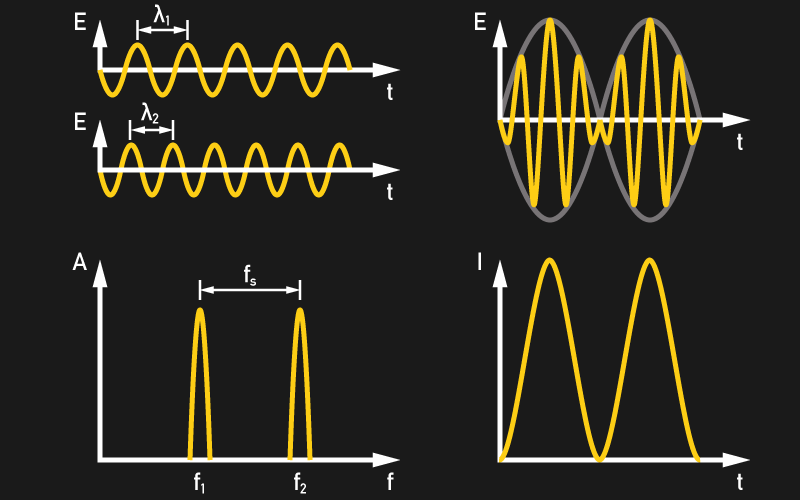
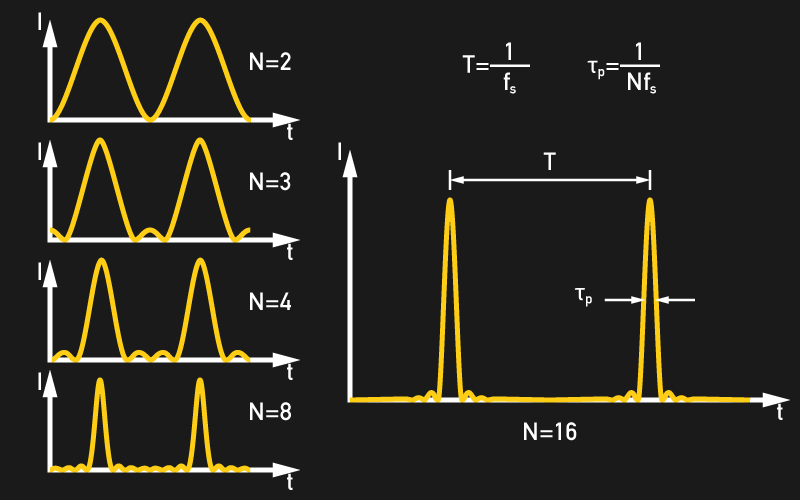
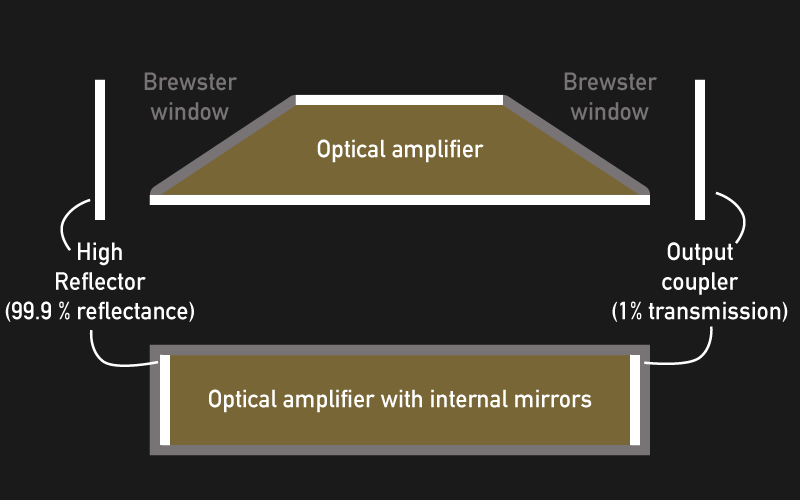
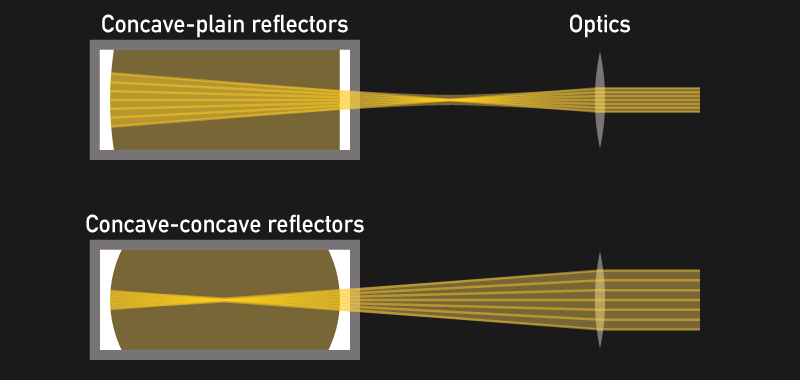














Awesome article!
Also check out MIT OpenCourseware’s laser fundamentals 1-3, they’re the best videos I’ve seen on this topic:
https://www.youtube.com/watch?v=saVE7pMhaxk
Indeed, those OCW videos done by Prof. Ezekiel are a really great introduction to lasers and optics. The later parts actually really dig down into some of the more interesting details about diffraction, interference, laser modes, etc. Plus, there are live demos of a wide variety of very neat lasers!
“I too have a new toy. You are looking at an industrial laser. It emits an extraordinary light not to be found in nature. It can project a spot on the moon, or, at closer range, cut through solid metal. I will show you”.
https://www.youtube.com/watch?v=DoQwKe0lggw
For anyone interested in specific terminology, this is a good place to start:
https://www.rp-photonics.com/encyclopedia.html
It’s a bit light on the exact details (hey, whaddya want.. they’re a consulting firm), but it’s a good start. You can likely supplement the rest with Wikipedia (or if you’re daring enough, open-access journals).
Great article! You cleared up a number of deficiencies in my understanding of lasers, and did so brilliantly. Thanks!
I’m still very curious about specifically how semiconductor lasers work, so I guess I have a bit more research to do. :)
It seems that I’m far too stupid to understand any of that :(
Oh well, back to hitting things with my hammer….
Well you know how you can wack stuff with the hammer and it rings with the same note each time and how if you hit something with the right rhythm the sound can get louder and louder, well it is a lot like that except there are a huge number of small hammers (photons) and you are thumping electrons, so the laser throws hammers back at you, but all at the same time.
+1
Question:
I thought the halogen present in such a bulb was just there as part of the halogen cycle, keeping the tungsten from being deposited on the envelope. What spontaneous emission is happening here?
Good point, the emission happening there is still spontaneous, but you’re right, it has nothing to do with the filling. Thanks!
“band can be as narrow as a few µHz” Microhertz?!?. Can we have a reference for such extraordinary performance?
Thermal broadening alone in a gas laser accounts for megahertz of linewidth. I built a device for measuring wavelength of single-mode liquid lasers, which (30 years ago, when I built it) had linewidths in the kHz range (and my device could resolve that). Quantum uncertainty alone would set a lower bound roughly in the Hz range. So how the heck is someone getting microhertz? Please! Tell us!
No clue how, but I’d bet good money it was someone working on LIGO or Advanced LIGO. Hopefully Moritz chimes in with sources.
Hi there, it’s hard to imagine, but it’s possible. Here’s a paper on sub-Hz linewidth: http://cpl.iphy.ac.cn/fileup/PDF/2012-7-073202.pdf
A remarkably readable and straightforward paper. It doesn’t give any insight how to achieve a further 5-6 orders of magnitude improvement in linewidth to the microhertz level though.
From the article:
“We can see that the laser linewidth decreases with ???? increasing. The laser quantum-limited linewidth can even reach µHz level.”
Doh. Eyes aren’t what they used to be. Thanks.
Another interesting read on the topic: Optical Coatings and Thermal Noise in Precision Measurement http://www.cambridge.org/us/academic/subjects/physics/optics-optoelectronics-and-photonics/optical-coatings-and-thermal-noise-precision-measurement
Yeah, LIGO is about the only thing that comes to my mind that might use such ridiculous linewidth. That and maybe some metrology (especially timing) applications.
I suspect they meant some other measurement there. Few lasers boast smaller than kilohertz bandwidth. For example: http://www.oewaves.com/narrow-linewidth-laser/subhertz
Very nice write up.
I think you guys should do a portion like this once each week. A great article (like this one) on something that most of us think we know how it functions but perhaps don’t fully understand why.
The section on pumping methods being replaced by semiconductors reads a little oddly. HeNe’s are not being pumped optically. Pumping in solid state lasers is increasingly being done with semiconductors and applications for other lasers are switching to semiconductor lasers.
The idiom ‘bottom of the barrel’ normally refers to desperation, all the good ideas have been used up and all the bad ideas have been used up and all that is left is the very worst ideas stuck to the bottom. I don’t understand the use here.
Hey there!
#1 A He-Ne laser at room temperature can never operate solid state because He-Ne is a gas. It can, however, be replaced as a whole with a solid-state laser diode if the application allows it. i.e. Barcode scanners
#2 Solid-state doesn’t always mean semiconductor. Xenon/Krypton arc lamps are in fact being replaced with diode-based solid-state solutions in crystal lasers such as Nd:YAG. Yes, the diodes are semiconductors, but you would not call that a semiconductor laser.
#3 Semiconductor lasers have not been covered (or mentioned) in this article. They deserve their own post. Also, semiconductor lasers do not necessarily pump optically, some also pump electrically.
#4 With the bottom of the barrel, it depends on if you are getting to the bottom of the barrel or if you are scraping it. I.e. sometimes you find a paper that really gets down to the bottom of the barrel of whatever topic you’re interested in. But then you find out that you have to pay for the download, and you’re really scraping the bottom of the barrel of your budget.
Thanks for reading the post!
Ahh, you are right about solid state, I read it wrong. I thought you were talking about the replacement of flash lamps with pump diodes and got confused.
Getting to the “bottom of something”, I see where are going now, but never heard it applied positively to barrels before, I’m still not quite convinced it works ;)
Congratulations on tackling a difficult subject well.
I hereby look forward to the announced diode laser article (although I could just consult the physics course notes I took). Nice article :-) Nearly all course notes and books sweep the exact origin of stimulated emission (origin of Einstein’s B coefficients) under the rug though, simply assuming its existence…
How is it that a few watts of laser light focused on a spot can create intense temperatures but not with non-laser light? Is it just that laser output is highly collimated and therefore can be better focused?
Its very difficult to focus non-coherent non-monochromatic light down to a tiny spot. Plus a lot of light sources are rated for their power in and not their output power. I do have some small high power light sources that focused will get thin metal very hot, hot enough to start warping it.
http://hackaday.com/2011/06/25/selective-solar-sintering-with-sand/
https://www.youtube.com/watch?v=6ajzOaauYa4
The small focal point and wavelength specific to the material being heated contributes significantly to the heating effect- certain wave,engths are absorbed better by particular materials.
Hey there! That’s an excellent question!
Intuitively, one might think that you can just focus down sunlight – or light from any source – to an almost singular spot (diffraction limited spot). But when you do so, the brightness of that spot will be zero. And then you know that actually you can’t.
Why? Because optics! The absolute amount of magnification of any lens is -S2/S1 with S1 being the distance between the lens and the light source and S2 being the distance between the lens and the image. So, to achieve a very small spot, you need to make S1 much larger than S2. But a larger S1 also means, that the lens is now far away from the (isotropic) lightsource. Thus, only a fraction of the original light makes it into your spot.
Therefore, it’s impossible to focus the light of a isotropic light source of a given size to a spot of a higher brightness than the light source even if the spot is smaller than the light source.
The fresnel experiment, where sunlight is focused to a small spot that can burn stuff, is also bound to this rule. It’s quite intuitive to imagine the inferno if the light intensity in the light spot created by a large fresnel lens would exceed the light intensity on the surface of the sun.
to be honest I don’t really like this explanation: in theory the lens could be arbitrarily large, and capture nearly half the emitted light from an isotropic point source, or alternatively an ellipsoidal mirror with the sun in one focus, and the target in the other to reflect all the light from the isotropic point source… I prefer the answer that with laser light many photons are in the same optical modes, and hence its easier to focus the lot. Also the temperature of the spot should not be confused with the optical power density at the spot, not only is the power density higher, the surface surrounding the target volume element scales down quadractically, so less heat can be conducted away for the same specific heat conductivity of the target material
I found this “conservation of radiance” concept is a hard one to explain. The term is “étendue”, and gory detail can be found at https://en.wikipedia.org/wiki/Etendue
With simple lenses it is tough to put even a small fraction of the power density of the source into a focused spot. For example, the sun is really bright: its surface power density is around 50 MW/m^2, but even a good magnifying glass puts less than a tenth of that, 5 MW/m^2 (5 watts per square millimeter) into its focal spot. You can do better than a simple lens magnifying glass, but you’ll never get better (or even very close) close to the intrinsic source brightness.
The *apparent* brightness of a laser is much, much higher. A decent quality laser pointer and a decent focusing lens (like a microscope objective) can convert its puny one milliwatt output into a power density well in excess of 100 watts per square millimeter — roughly what a DVD sees from its laser. This all because the source really does have an apparent surface brightness that intrinsically bright — source coherence is a side effect of the generation process, and with collimation can make nice a clean directed beam, but the power density you can achieve is because a laser source really is that bright.
(Similarly, if you have an illuminated surface that your are trying to image (say, onto a camera sensor), you’ll find that it’s very difficult to get more than even one percent of the light emitted from that surface onto your camera sensor.)
no edit…
“but you’ll never get better (or even very close) close to the intrinsic source brightness.”
That is, except in the case where you can play with the index of refraction: you can boost power density inside the optic by n^2. So, go ahead, make your solar concentrators out of solid diamond… :-)
Grab a magnifying glass and focus the suns rays to a small dot on a piece of paper/wood/plastic/your finger
I have a true curiosity regarding the laser & how it’s generating strong light (photo). This article is more than awesome to explain everything I need. Thanks.
I didn’t know it until reading this article. It makes me remember the time learning the scientific subject at secondary school
To create your own diy laser, simply take apart a CD or DVD drive, the laser part of the disc reader can be used to output laser light which the electricity is fed onto it.